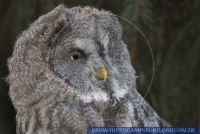Strix nebulosa
Great Gray Owl
Exif Keywords:
Exif ImageDescription: Strix nebulosa, Bartkauz, Great Gray Owl
The Great Grey Owl or Lapland Owl (Strix nebulosa) is a very large owl, distributed across the Northern Hemisphere. Adults have a big, rounded head with a grey face and yellow eyes with darker circles around them. The underparts are light with dark streaks; the upper parts are grey with pale bars. This owl does not have ear tufts and has the largest "facial disc" of any raptor. In terms of length, the Great Grey Owl rivals the Eurasian Eagle Owl and the Blakiston's Fish Owl as the world's largest owl. However, much of its size is deceptive, since this species' fluffy feathers, long tail and large head obscure a body lighter than most other large owls. The length may range from 61 to 84 cm (24 to 33 inches), averaging 72 cm (28 inches) for females and 67 cm (26 in) for males. The wingspan can exceed 152 cm (60 inches), but averages 142 cm (56 in) for females and 140 cm (55 in) for males. The adult weight can range from 700 to 1800 grams (1.5 to 4 lbs), averaging 1290 grams (2.8 lbs) for females and 1000 g (2.2 lbs) for males....Their breeding habitat is the dense coniferous forests of the taiga, near open areas, such as meadows or bogs. Great grey owls do not build nests, so typically use nests previously used by another large bird, such as a raptor. They will also nest in broken-top trees and cavities in large trees. Nesting may occur from March to May. 4 eggs is the usual clutch size. Eggs average 42.7 mm (1.7 inches) wide and 53.5 mm (2.1 inches) long. The incubation period is about 30 days, ranging from 28 to 36 days. Brooding lasts 2 to 3 weeks, after which the female starts roosting on a tree near nests. The young jump or fall from the nest at 3 to 4 weeks, and start to fly 1 to 2 weeks after this. Most offspring remain near their natal sites for many months after fledging. The abundance of food in the area usually affects the number of eggs a female lays, which is quite common in owl species. If food is scarce, they may travel a short distance to find more prey. However, they do not migrate. These birds wait, listen and watch for prey, then swoop down; they also may fly low through open areas in search of prey. Their large facial disks focus sound, and the asymmetrical placement of their ears assists them in locating prey. On the nesting grounds, they mainly hunt at night and near dawn and dusk; at other times, they are active mostly during the night. They have excellent hearing, and may capture prey moving beneath 60 cm (2 feet) of snow in a series of tunnels. These owls can crash through snow that could support the weight of a 180-pound person. Unlike the more versatile eagle and horned owls, Great Grey Owls reply almost fully upon small rodents, with voles being their most important food source. Locally, alternative prey animals (usually comprising less than 20% of prey intake) inlude hares, moles, shrews, weasels, thrushes, grouse, Gray Jays, small hawks and ducks. Great Grey Owl juveniles may themselves fall prey to bears, Fisher (animal)s, and large hawks, especially Northern Goshawks; while adults may fall prey to Bubo (genus) owls and lynxes. The call of the adult is a series of very deep, rhythmic whoos, which is usually given in correlation to their territories or in interactions with their offspring. At other times, adults are normally silent. The young may chitter, shriek or hiss. The harvest of timber from the Great Grey Owl's habitat is, perhaps, the greatest threat to this species. Intensified timber management typically reduces live and dead large-diameter trees used for nesting, leaning trees used by juveniles for roosting before they can fly, and dense canopy closures in stands used by juveniles for cover and protection. If perches are not left in clearcuts, Great Gray Owls cannot readily hunt in them. Although human-made structures (made specifically for use by this species) have been utilized by these owls, the species is far more common in area protected from logging. Livestock grazing in meadows also adversely affects Great Gray Owls, by reducing habitat for preferred prey species. Source:Wikipedia
Viewed 5158 times









